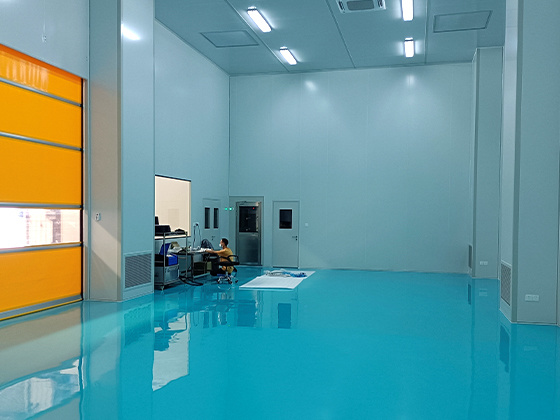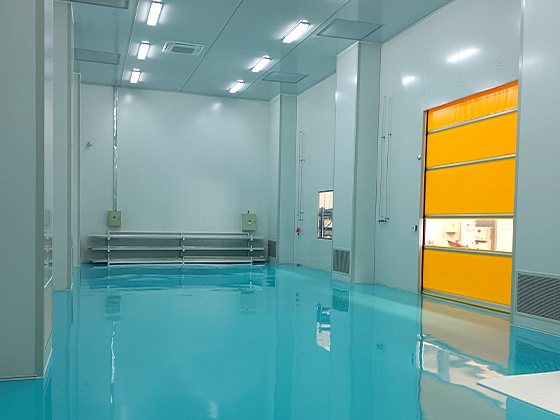Clean room management specification
Release Time:
2023-03-07
Pageviews:
1. Personnel entering the clean room must abide by the "Clean Room Management System;
2. Employees who have not been authorized and foreign guests who need to enter the clean room should first obtain permission from the person in charge of production, or be accompanied by business personnel before entering
3. Anyone who enters the clean room to work or participate in the field must change into anti-static clothing, a hat, and anti-static shoes in accordance with the regulations:
4. Items irrelevant to production and prone to dust are not allowed to be brought into the clean room. Smoking, eating and non-productive activities in the clean room are strictly prohibited. Offenders will be fined 100 yuan;
5. Before entering the dressing room, take off your outer shoes and put them in the shoe cabinet. It is forbidden to enter the dressing room without taking off your shoes:
6. When entering the changing room, change into dust-free clothes. The hair must be covered in the hood, and dust-free shoes should be tied, and then enter the air shower room;
7. Open the door and enter the air shower room. The maximum number of people is 3 people at a time. Close the door and the air shower will start automatically. During the air shower, shake your hands and rotate 360 degrees. After the fan stops working, the buzzer will sound, the inner door will be unlocked, and you will go out of the air shower room ;
8. When materials enter the dust-free workshop, they need to be unpacked and cleaned outside first, open the outer door of the cargo shower, put the materials in the debt shower room, and open the inner door of the cargo shower to take the materials after entering from the air shower;
9. It is strictly forbidden for personnel to enter the clean room directly through the cargo shower without passing through the air shower. The cargo shower only allows the entry and exit of materials and emergencies;
10. When working in a clean room, the operator should move lightly. Strictly implement the operating procedures, do not allow running, jumping, fighting and shouting, do not make unnecessary movements, do not make dust-prone and large-scale movements
11. When workers are working in the clean room, try to avoid the phenomenon of group photo gathering: If individual workstations have no special collaboration requirements, employees at other workstations are prohibited from gathering and watching other workstations that have nothing to do with their own workstations work normally. event;
12. Personnel without a room shall not take off the dust-free clothes during the operation and before exiting to the more agricultural area after the operation;
13. When personnel exit, directly pass through the air shower, enter the dressing room, take off the non-sit shoes first, and then take off the dust-free clothes
14. Do not touch the floor, tables and other items when taking off the dust-free clothes, and hang them in the specified places with hangers:
15. After taking off the clean clothes, if it is necessary to enter the clean room again, it is still necessary to perform human cleaning in the order of entering the clean room;
16. Do not wear dust-free clothes to the toilet or enter other workshops, warehouses and other unclean areas;
17. Work in the clean room cannot be frequently entered and exited, no more than 2 times in half a day, and it is necessary to find someone outside the clean room for assistance with items.



Latest News
2024-09-03
Abstract: Oil deacidification is an important step in food processing, which aims to remove free fatty acids in oil and improve its quality and stability. Traditional deacidification methods have some limitations, such as low efficiency, high energy consumption, and loss of nutrients. In recent years, molecular distillation technology has gradually attracted attention as a new deacidification method. This article will introduce the application of molecular distillation in oil deacidification, including the principle, operation process and advantages, and focus on the outstanding advantages of Aishengke in molecular distillation technology.
Vitamins are products that are closely related to people's lives, and have become one of the main bulk products in the international pharmaceutical and health care products market. The amount of vitamin E is the largest, followed by vitamin A, vitamin C, vitamin D and so on. With the growth of economy and the improvement of people's living standards, the demand for vitamin products will further increase, and people's requirements for their quality and grade will also further increase. Therefore, as an important separation technology in the production of many vitamins, molecular Distillation technology will also play an increasingly important role in the vitamin industry.
Glyceryl monostearate (GMS), abbreviated as monoglyceride, is produced from natural vegetable oils and fats. The active ingredient is purified by molecular distillation technology to more than 90%, also known as molecular distillation monoglyceride. It is the most widely used food Additives, safe to use in the production and processing of food, medicine, plastics, etc., account for more than half of the emulsifier consumption in the market.
The principle of molecular distillation is to make use of the different degrees of affinity between different molecules. By controlling the conditions such as temperature and pressure, the mixture begins to vaporize. Different components in the vapor form liquids in the condenser and are separated according to their boiling points. This distillation method not only has a good separation effect, but also can be repeatedly separated and purified, and is widely used in chemical, pharmaceutical and other fields.
Molecular distillation is a common chemical method used to separate and purify compounds. In the pharmaceutical industry, molecular distillation is widely used in pharmaceutical purification. This article will focus on the application of molecular distillation in pharmaceutical purification and provide some specific examples.
Laboratory vacuum distillation equipment has undergone significant advancements in recent years, driven by the need for higher efficiency, improved safety, and enhanced user experience.
Global recruitment of distributors
If you recognize the brand, technology, products and market prospects of Aishengke, we look forward to establishing a strategic partnership with you for win-win cooperation and development. Looking forward to your joining!

